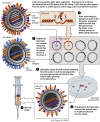Influenza gain-of-function experiments: their role in vaccine virus recommendation and pandemic preparedness
- PMID: 25505124
- PMCID: PMC4278542
- DOI: 10.1128/mBio.02430-14
Influenza gain-of-function experiments: their role in vaccine virus recommendation and pandemic preparedness
Abstract
In recent years, controversy has arisen regarding the risks and benefits of certain types of gain-of-function (GOF) studies involving avian influenza viruses. In this article, we provide specific examples of how different types of data, including information garnered from GOF studies, have helped to shape the influenza vaccine production process-from selection of candidate vaccine viruses (CVVs) to the manufacture and stockpiling of safe, high-yield prepandemic vaccines for the global community. The article is not written to support a specific pro- or anti-GOF stance but rather to inform the scientific community about factors involved in vaccine virus selection and the preparation of prepandemic influenza vaccines and the impact that some GOF information has had on this process.
Copyright © 2014 Schultz-Cherry et al.
Figures


References
-
- World Health Organization 2008, posting date Influenza. World Health Organization, Geneva, Switzerland. http://www.who.int/immunization/topics/influenza/en/.
-
- Freidl GS, Meijer A, de Bruin E, de Nardi M, Munoz O, Capua I, Breed AC, Harris K, Hill A, Kosmider R, Banks J, von Dobschuetz S, Stark K, Wieland B, Stevens K, van der Werf S, Enouf V, van der Meulen K, Van Reeth K, Dauphin G, Koopmans M, FLURISK Consortium 2014. Influenza at the animal-human interface: a review of the literature for virological evidence of human infection with swine or avian influenza viruses other than A(H5N1). Euro Surveill. 19:pii=20793 http://www.eurosurveillance.org/ViewArticle.aspx?ArticleId=20793. - PubMed
-
- World Health Organization 2014, posting date Avian influenza in humans. WHO, Geneva, Switzerland.
Publication types
MeSH terms
Substances
LinkOut - more resources
Full Text Sources
Other Literature Sources
Medical
